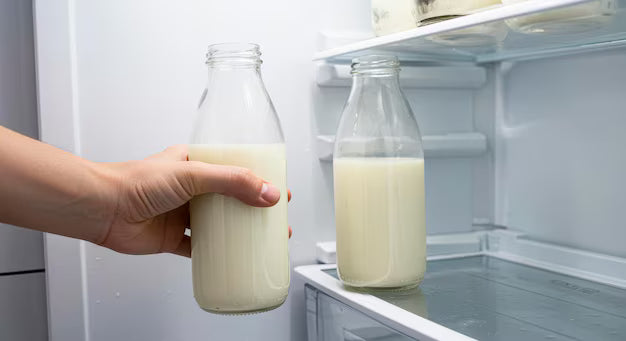
How Long Does It Take for Milk to Freeze?
Share
Freezing milk is one of the most effective ways to extend its shelf life, whether you are dealing with regular dairy milk or precious breast milk. Parents, caregivers, and even individuals who want to preserve milk for later use often ask the same question: how long does it take for milk to freeze?
The answer depends on several factors, including the type of milk, the container used, the freezer’s temperature, and the initial milk temperature. On average, it takes about 3 to 5 hours for milk to freeze solid in a standard home freezer set at 0°F (-18°C). However, this timeline can vary.
Why Freezing Milk Matters
Freezing milk allows parents to build a reserve, especially for working mothers or families with busy schedules. Breast milk, often referred to as liquid gold, is packed with essential nutrients, antibodies, and enzymes that help protect your baby. Freezing helps preserve these nutrients for later use, while proper handling prevents spoilage.
Using freeze-dried breast milk powder can also be an alternative for long-term storage, offering convenience and portability.
Factors That Affect Milk Freezing Time
Several elements impact how long milk takes to freeze:
1. Freezer Temperature
-
A freezer set to the recommended 0°F (-18°C) will freeze milk faster and preserve its quality better.
-
Freezers with fluctuating temperatures may take longer to freeze milk completely.
2. Type of Milk
-
Breast Milk: Freezes slightly faster than cow’s milk because of its composition and lower fat density. The average breast milk freezing time is 2–4 hours.
- Whole Cow’s Milk: Takes around 3–5 hours to fully freeze. Skim milk may freeze a little faster since it contains less fat.
For more on breast milk storage, read How Long Can Breast Milk Stay Out.
3. Initial Milk Temperature
-
Milk that is freshly pumped and warm will take longer to freeze. Pre-chilling milk in the refrigerator for 30–60 minutes before freezing can reduce freezer shock and speed up solidification. Learn more about boosting milk supply at How to Increase Breast Milk Supply.
-
For efficiency, it’s best to refrigerate milk for 30–60 minutes before transferring it to the freezer.
4. Container Type
-
Freezing in Bags vs. Bottles:
-
Thin breast milk storage bags freeze faster because of their flat shape.
-
Bottles (plastic or glass) take longer as they are thicker and hold milk in a denser form.
-
Bags are ideal for quick freezing and compact storage, while bottles are sturdier and reduce leakage risks.
5. Amount of Milk
-
Smaller portions (2–4 ounces) freeze quicker and are more convenient for thawing.
- Large bottles or bags may take 5+ hours to solidify completely.
Breast Milk Freezing Time vs. Regular Milk
When it comes to time to solidify breast milk, freezing is usually quicker compared to dairy milk. This is due to its lower fat and sugar content, which allows ice crystals to form more efficiently.
-
Breast milk in storage bags: 2–3 hours.
-
Breast milk in bottles: 3–4 hours.
-
Cow’s milk (whole): 3–5 hours.
-
Cow’s milk (skim/low-fat): 2–4 hours.
If you’re storing large amounts of breast milk, it may take overnight to completely solidify.
Freezer Settings for Milk
Correct freezer settings for milk are essential to ensure milk freezes quickly and safely.
-
Standard Setting: 0°F (-18°C).
-
Deep Freezers: Can go as low as -20°F (-29°C), allowing for faster freezing and longer storage.
- Avoid Frequent Door Opening: This causes temperature fluctuations, delaying the freezing process.
For tips on safe milk handling, see Milk Temperature for Baby.
How to Freeze Milk Quickly
If you need to preserve milk fast, here are some strategies:
-
Use breast milk storage bags and lay them flat for faster freezing.
-
Pre-chill milk in the refrigerator before transferring it to the freezer.
-
Space out containers to allow proper air circulation around them.
-
Keep the freezer organized so the milk gets maximum exposure to cold air.
For mothers with large amounts of breast milk, rotating frozen milk (first in, first out) ensures the oldest supply is used first while maintaining freshness.
Spoilage Timeline for Frozen Milk
Freezing milk extends its usability, but it won’t last forever. The spoilage timeline depends on storage conditions:
Breast Milk:
-
Standard freezer: Up to 6 months (best within 3 months).
-
Deep freezer: Up to 12 months.
Cow’s Milk:
-
Best used within 3 months for taste quality.
-
Technically safe for 6 months, but may develop changes in flavor and texture.
Once thawed, milk should never be refrozen, as this increases the risk of bacterial growth and spoilage.
Best Practices for Freezing Milk
-
Store milk in small, portioned amounts for convenience.
-
Label and date each container for easy tracking.
-
Avoid overfilling bottles, as milk expands when frozen.
- Always place milk at the back of the freezer, not the door, to avoid temperature changes.
Common Concerns About Freezing Milk
Does freezing affect milk nutrients?
-
Freezing breast milk preserves most nutrients, but some antibodies and enzymes may reduce slightly.
-
For cow’s milk, freezing may alter taste and texture, but it remains safe to drink.
Why does frozen breast milk smell soapy?
-
High lipase activity can cause a soapy odor. This is harmless and does not indicate spoilage. Scalding milk before freezing can reduce this. Learn more at Lipase Breast Milk.
Conclusion
So, how long does it take for milk to freeze? The average time is 3–5 hours, depending on milk type, storage container, and freezer settings. For faster results, use flat storage bags, pre-chill milk, and maintain an efficient freezer temperature.
For parents storing breast milk or households stocking dairy milk, following safe milk handling and storage practices ensures your milk remains nutritious, fresh, and safe to use even months later.
FAQs
How long does it take for breast milk to freeze?
Breast milk usually takes about 2–4 hours to freeze, depending on the container and your freezer’s efficiency. Storage bags generally freeze faster because they are thin and allow milk to spread out evenly, while bottles take longer since the milk is stored in a thicker, more compact shape.
Can I freeze freshly pumped breast milk immediately?
Yes, you can place freshly pumped milk directly in the freezer. However, many experts suggest refrigerating it for 30–60 minutes first. This step helps bring the milk to a cooler temperature, which reduces freezer shock, preserves nutrients better, and allows the milk to freeze more quickly once placed in the freezer.
Does cow’s milk freeze at the same speed as breast milk?
Not exactly. Whole cow’s milk usually takes slightly longer to freeze compared to breast milk because of its higher fat content and thicker consistency. On average, it can take 3–5 hours to solidify fully, while breast milk often freezes faster.
Is freezing in bags faster than in bottles?
Yes. Bags freeze faster because they allow the milk to lie flat and spread out, which creates a larger surface area for cold air to circulate. Bottles, on the other hand, are more compact and thicker, so the freezing process can take 1–2 hours longer than when using bags.
What’s the best freezer setting for milk?
For best results, your freezer should be set at 0°F (-18°C) or lower. This temperature ensures the milk freezes thoroughly and stays safe for long-term storage. A deep freezer, which is colder and more consistent than a regular freezer, can extend the storage life even further.
Can I speed up the milk freezing process?
Yes, there are a few tricks. Use flat storage bags instead of bottles, since they freeze faster. Spread the bags out rather than stacking them, and place them at the back of the freezer where the temperature is coldest. Also, avoid opening the freezer door too often, as this allows warm air to enter and slows down the freezing process.
How long can frozen breast milk last?
In a standard freezer attached to a refrigerator, breast milk can be stored for up to 6 months, though it is best used within 3 months for maximum freshness. In a deep freezer, which maintains lower and more stable temperatures, breast milk can last up to 12 months.
What happens if frozen milk looks separated?
Separation is completely normal and happens because fat rises to the top when frozen. Once thawed, simply swirl or shake the container gently to mix it back together. However, if the milk smells sour or has a strange odor after thawing, it should be discarded, as this could indicate spoilage.
Can I refreeze thawed milk?
No. Once breast milk has been thawed, it should never be refrozen. Thawed milk should be consumed within 24 hours if kept in the refrigerator. Refreezing can encourage bacterial growth and reduce the nutritional quality of the milk, making it unsafe for the baby.
Does freezing milk change its taste?
Yes, freezing can slightly alter the taste. Cow’s milk may taste a little different due to fat separation and changes in texture. Breast milk may sometimes develop a soapy odor caused by lipase, an enzyme that breaks down fat. Although the taste may seem different, the milk is usually still safe to feed your baby unless it smells rancid or sour.
